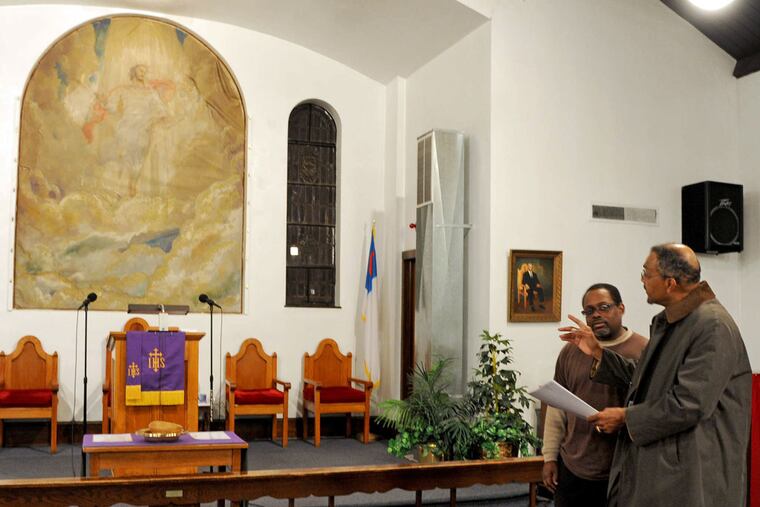Artwork could spur Camden church's rebirth
A depiction of the Second Coming of Jesus could help revive a little church in North Camden. The faded, water-damaged, but still-grand canvas bears the name of H. Willard Ortlip, who left Philadelphia society portraiture behind to become an international street preacher - and a painter of sacred subjects on a grand scale.

A depiction of the Second Coming of Jesus could help revive a little church in North Camden.
The faded, water-damaged, but still-grand canvas bears the name of H. Willard Ortlip, who left Philadelphia society portraiture behind to become an international street preacher - and a painter of sacred subjects on a grand scale.
At the former Wesleyan Methodist church, now Mount Carmel Holy Church, the simple, well-kept sanctuary is dominated by a majestic painting of Jesus descending from the heavens. The painting was finished in 1940.
"We'd like to restore it," says Mount Carmel's pastor, Bishop Kenneth Feaster. "But we'd consider selling."
He notes that the independent Pentecostal congregation is hoping to renovate its currently unused parsonage and fellowship hall.
"I can't say selling it isn't a possibility," co-pastor Michael Benson says. "But that's not our first thought."
Founded in South Camden, Mount Carmel purchased the church at Sixth and Erie Streets in 1967. Membership has dwindled from 200 to about 30.
But North Camden may be turning around - the church overlooks the restored Pyne Poynt Park - and members say the congregation is poised to grow.
"We need to uplift the facilities. I'm not sure how the painting fits into that," says Matthew Grimes, a church elder.
"It's a beautiful painting, but it could be shared with others, in a museum, so that they could see the beauty of it," he says, adding, "As long as I've known this church, I've known that painting. But we have so many other needs."
The painting "has historical value to the city. It would be great if there were support for restoring it from the community and from foundations," says Alfred J. Dansbury Sr., who has photographed Camden since 1971.
Dansbury took pictures of the painting at the request of T.J. Carter, a semiretired construction manager who grew up in Camden and volunteered to help plan the church renovations.
"My late mother, Catherine Willeen Carter, was a member of Mount Carmel since 1957," Carter says from his home in Douglasville, Ga. "She was well aware of that painting."
If restored, he says, it could be used to promote the church renovation.
"Anything that would help the survival of that church, I would be in favor," Carter said. "And my mother would be, too."
Dansbury, a grants analyst with the city's planning department, has researched and written about Ortlip.
The artist was born in Norristown in 1886, studied at the Pennsylvania Academy of the Fine Arts, and painted covers for Collier's and other magazines. Two of his secular works (including a male nude) are in the Smithsonian's art collection.
Ortlip also drew illustrations for a popular series of Bible stories; religious-themed paintings of his can be found in clerical buildings from Buffalo, N.Y., to Pasadena, Calif., as well as at Houghton College in Upstate New York.
He and his wife, Aimee, also an accomplished artist, taught at that small Christian college, where a campus art gallery still bears their family's name.
In 1979, the Salmagundi Club on Manhattan's Fifth Avenue mounted a retrospective exhibition of Ortlip, whom they described as "one of America's most eminent illustrators." It included more than 100 works, including watercolors and canvasses.
There's also an enormous Ortlip canvas in the front of the First Wesleyan Church sanctuary in Florence, Burlington County. It depicts the risen Jesus above Jerusalem.
"I've been told that ours is one of the brightest, largest, and most beautiful of his paintings," says the Rev. Philip Loria, First Wesleyan's pastor. "It's exquisite."
The painting is dated 1950, the year the church was founded by Lois Richardson and Carrie Hazzard - a prominent pair of clergywomen who earlier had pastored at what is now Mount Carmel.
Theodore Murphy, a professor of art at Houghton, says he particularly admires Ortlip's portraits.
Some Ortlip works in the college collection have been appraised for as much as $20,000. But Murphy notes that a piece of art's market value also depends on what buyers are willing to pay.
Given the condition of the North Camden painting - portions appear to have separated and then been stitched back together - I doubt selling it would yield enough money to underwrite the renovation project.
So restoration of the painting will require a serious fund-raising effort, professional assistance, and faith.
That's something Mount Carmel Holy Church, standing proud despite decades of struggle, seems to have plenty of.
856-779-3845 @inqkriordan